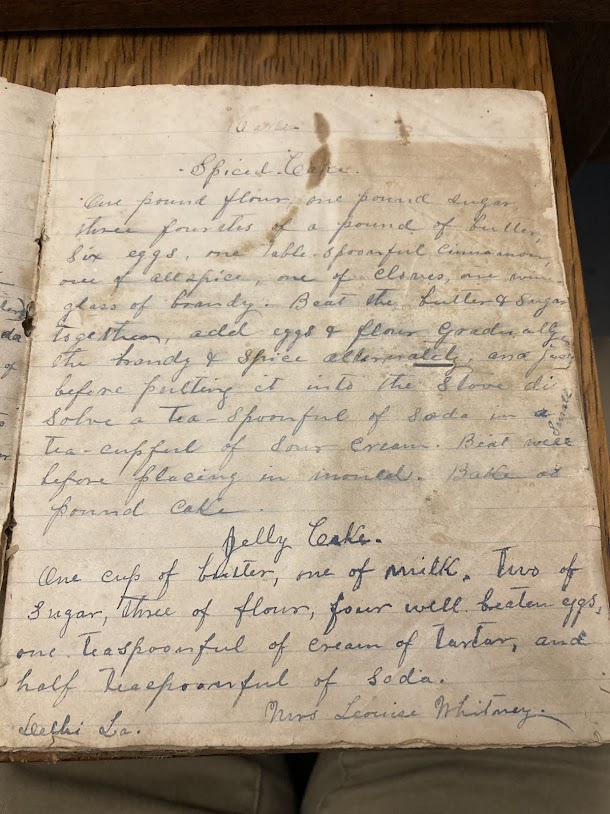Delicacies from the Basement at BPL
The weather has been cold and wet and that makes me want something cozy to eat. In this case, I found a recipe for spice cake in a recipe book Kate Herman from 1973 in the Birmingham Department of Archives & Manuscripts.
The warm flavors of cinnamon and cloves remind me of the holidays. Even in ancient times nobility and workers would have enjoyed this recipe alike, though Spice Cake may have been called something a little different. What has now become spiced cake used to go by many other names such as Honey cake, Oat cake, and Fruit cake. As the recipe evolved and traveled around the world it would take on the local and available ingredients.
In the medieval period, spiced cake would have used honey instead of sugar. In the Americas, it would be made with molasses. However, the core of the recipe has stayed the same to create a sweet treat that everyone can enjoy. In modern days the spices used to call to mind cold weather, hot tea, and coffee. The spices blend to create a holiday treat that is simple and rewarding to make.
While the recipe that I used is from a recipe book taken from 1873, it differs only a little from modern-day recipes. The recipe calls for creaming the butter and sugar and then adding eggs and flour slowly to mix well and then to add the spices. Where this recipe differs significantly is adding brandy and sour cream. While adding brandy or other flavorful liquors to baking is common, this is the first time I have come across this choice in a spice cake. Especially compared to other modern recipes.
The second interesting ingredient is sour cream. While today sour cream is a common ingredient to bake other foods it would not have been as common in the 1800s. Sour cream is commonly used to fluff or moisten baked goods. Sour cream in the 1870s was created using a similar method to buttermilk or sweet milk.
By turning cream and allowing the naturally forming bacteria into the cream it thickens into a cream-like substance. It is believed that sour cream originated in the Middle East and would have originally been made from mare’s milk. The fermented milk, called koumiss, would be a precursor to yogurt and other milk-based ingredients.
As the practice spread from the Middle East to Europe, mares’ milk was exchanged for cows’ milk and the process was altered to stop fermentation. The new substance is more in line with what we think of as sour cream today. Sour cream during the 1870s would not have been bought in stores but would have been made in the home along with other ingredients.
Brandy is a spirit made from distilling wine. It has an illustrious history stemming from many wine countries that have perfected the art over the centuries. Some of these countries include France and Spain. With its spread through Europe Brandy made its way to England and to the colonies where it was favored as a digestif for after dinner. Brandy also has an illustrious history with cooking, it is often added to meats and soups to intensify flavors or add coloring.
For the spice cake in particular, Brandy has a storied past. Brandy has often been used in festive baking, such as spicy cakes and holiday puddings to the point that such liquor has become a holiday drink that fits neatly with the genre of spice cake.
When I tried to make this recipe, I was worried that the ingredients listed would make far too much for me and my coworkers to eat. So, with help from my colleagues, I transferred the ingredients to cups and halved the recipe. I then followed the ingredients as closely as possible to the original.
One issue that came up was that the oven temperature was not provided. So on the recommendation from my coworker, I used 350 degrees Fahrenheit and cooked the cake for about 45 minutes. I occasionally checked with a knife inserted into the middle until it came out clean.
Don’t forget to grease the pan!
While the cake tasted fine, it was overly sweet and had a tough exterior. If I were to try this recipe again, I would make sure that the dough had enough moisture and lower the sugar content.
The spices worked wonderfully, and the cake was a pleasant holiday treat. If the cake had been a little less sweet, I could see it going well with a cup of coffee or tea.
If you are interested in making this cake you can find the recipe below transcribed from Kate Herman’s recipe book dated 1873.
If you are interested in looking at the recipe book yourself the Archives are open Monday through Thursday and on Saturdays for appointments from 10:00 a.m. to 5:00 p.m.
If you have any questions you can email me at connor.marullo@cobpl.org.
Sources: Encyclopedia Brittanica, Napa Valley Brandy Co.
Transcribed Recipe (From Kate Herman's 1973 recipe book)
Once pound flour
One pound sugar
Three fourths of a pound of butter
Six eggs one table spoonful cinnamon of allspice
One of cloves
One wine glass of brandy
Teaspoonful Baking soda
Teacupful sour cream
Directions:
Beat the butter and sugar together, add eggs and flour gradually.
The brandy and spice alternatively and just before putting it into the stove dissolve a teaspoonful of soda in a teacupful of sour cream.
Beat well before placing in mold bake as pound cake.
By Connor Marullo, Assistant Archivist|Birmingham Public Library Department of Archives & Manuscripts


Comments